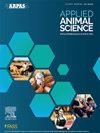Perspective and Commentary: Summary of the Special Issue on calf and stocker performance effects on feedlot performance and thoughts on future research
IF 1.5
Q3 AGRICULTURE, DAIRY & ANIMAL SCIENCE
引用次数: 0
Abstract
Purpose
The objective of this article was to summarize information in 7 original research articles and 2 reviews submitted, reviewed, and accepted for this Special Issue on possible preweaning calf and stocker calf performance factors influencing subsequent feedlot performance. Additionally, thoughts regarding future directions for research are presented.
Sources
A call for papers was released in early 2024 for topics that evaluated the effects of postweaning management on subsequent feedlot performance in beef cattle. Seven original research articles and 2 reviews were submitted.
Synthesis
This Special Issue represents research findings and reviews of information to expand our understanding of factors in the preweaning and stocker phases that might influence subsequent feedlot performance. Information is presented in the Health, Nutrition, and Production and Management sections. The segmented nature of the beef industry leads to segmented areas of research focused on the individual cow-calf, stocker, and feedlot segments. Thus, there is a dearth of consistent information examining long-term effects of pre- and postweaning treatments and factors across the various segments, including feedlot performance and carcass characteristics.
Conclusions and Applications
Our goal for this Special Issue was to identify and address some of the knowledge gaps. As noted in the 2 reviews, data regarding long-term effects needs to be collected in a more standardized and consistent way among various research locations. Although the research findings submitted to this Special Issue add to our body of knowledge, there are still many other avenues to explore. However, given the complexity of a system-type approach to fully explore these questions, it is imperative that researchers and Extension personnel collaborate (across state and regional lines) to find ways to address these needs.
展望与评论:《犊牛和家畜生产性能对饲养场生产性能的影响》特刊综述及对未来研究的思考
目的总结本期特刊投稿、审稿和接受的7篇原创研究文章和2篇综述,探讨预断奶犊牛和后备犊牛生产性能可能的影响因素。此外,对未来的研究方向提出了思考。资料来源2024年初发布了一份论文征集,主题是评估断奶后管理对肉牛后续饲养场性能的影响。提交原创研究论文7篇,综述2篇。本特刊代表了研究成果和信息综述,以扩大我们对断奶前和饲养阶段可能影响随后饲养场性能的因素的理解。信息载于保健、营养和生产与管理部分。牛肉产业的细分性质导致了细分的研究领域,主要集中在个体小牛,牲畜和饲养场部分。因此,缺乏关于断奶前和断奶后处理的长期影响以及各部分因素(包括饲养场性能和胴体特征)的一致信息。结论和应用我们本期特刊的目标是识别和解决一些知识空白。正如在这两篇综述中所指出的,关于长期影响的数据需要在不同的研究地点以更标准化和一致的方式收集。虽然提交给本期特刊的研究成果增加了我们的知识体系,但仍有许多其他途径有待探索。然而,考虑到充分探索这些问题的系统类型方法的复杂性,研究人员和推广人员(跨州和区域线)合作寻找解决这些需求的方法势在必行。
本文章由计算机程序翻译,如有差异,请以英文原文为准。
求助全文
约1分钟内获得全文
求助全文

 求助内容:
求助内容: 应助结果提醒方式:
应助结果提醒方式:


